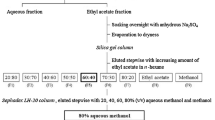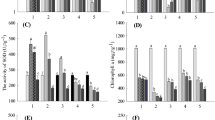Abstract
In an earlier work, we found that the failure of herbaceous plants to grow under sour orange was mainly due to an allelopathic mechanism. Four nonvolatile inhibitors were isolated by paper chromatography. Color reactions of all the inhibitors indicated that they are phenolic in nature. On the other hand, five volatile inhibitors were detected by gas chromatography, four of which were terpenes. All inhibitors reduced seed germination and/or seedling growth ofAmaranthus retroflexus.
Similar content being viewed by others
References
AlSaadawi, I.S., andAlRubeaa, A.J. 1985. Allelopathic effects ofCitrus aurantium L. I. Vegetational patterning.J. Chem. Ecol. 11:1527–1534.
AlSaadawi, I.S., andRice, E.L. 1983. Allelopathic effects ofPolygonum aviculare L. II. Isolation, characterization and biological activities of phytotoxins.J. Chem. Ecol. 8:1011–1023.
Bray, H.A., Thorp, W.V., andWhite, K. 1950. The fate of certain organic acids and amides in the rabbit. 10. The application of paper chromatography to metabolic studies of hydroxybenzoic acids and amides.Biochem. J. 46:271.
Del Moral, R., andMuller, C.H. 1970. The allelopathic effects ofEucalyptus camaldulensis.Am. Midl. Nat. 83:254–282.
Del Moral, R., andGates, R.G. 1971. Allelopathic potential of the dominant vegetation of western Washington.Ecology 52:1030–1037.
Einhellig, F.A., andRasmussen, J.A. 1978. Synergistic inhibitory effects of vanillic andp-hydroxybenzoic acids on radish and grain sorghum.J. Chem. Ecol. 4:425–436.
Harborne, J.B. 1977. Introduction to Ecological Biochemistry. Academic Press, N.Y.
Horsley, S.B. 1977. Allelopathic interference among plants. 11. Physiological modes of action, pp. 93–136,in H.E. Wilcox and A.F. Hamer (eds.). Proceedings of the Fourth North American Biology Work Shop. School of Continuing Education. College of Environmental Science and Forestry, Syracuse, N.Y.
Muller, C.H. 1966. The role of chemical inhibition (allelopathy) in vegetational composition.Bull. Torrey. Bot. Club 93:332–351.
Putnam, A.R. 1983. Allelopathic chemicals.Chem. Eng. News 6(14):34–45.
Rasmussen, J.A., andEinhellig, F.A. 1977. Synergistic inhibitory effects ofp-coumaric and ferulic acids on germination and growth ofSorghum.J. Chem. Ecol. 3:197–205.
Rice, E.L. 1979. Allelopathy. An update.Bot. Rev. 45:15–109.
Smith, I. (ed.) 1960. Chromatographic and Electrophoretic Techniques, vol. I, Chromatography. Wiley-Interscience Publishers, N.Y.
Tukey, H.B., Jr. 1969. Implications of allelopathy in agricultural plant science.Bot. Rev. 35:1–16.
Whittaker, R.H. 1971. The chemistry of communities, pp. 10–18,in Biochemical Interaction in Plants. Environmental Physiol. Subcommittee; U.S. Nat. Comm. IBP. eds, National Academy of Science, Washington, D.C.
Author information
Authors and Affiliations
Rights and permissions
About this article
Cite this article
AlSaadawi, I.S., Arif, M.B. & AlRubeaa, A.J. Allelopathic effects ofCitrus aurantium L.. J Chem Ecol 11, 1527–1534 (1985). https://doi.org/10.1007/BF01012198
Received:
Accepted:
Issue Date:
DOI: https://doi.org/10.1007/BF01012198




